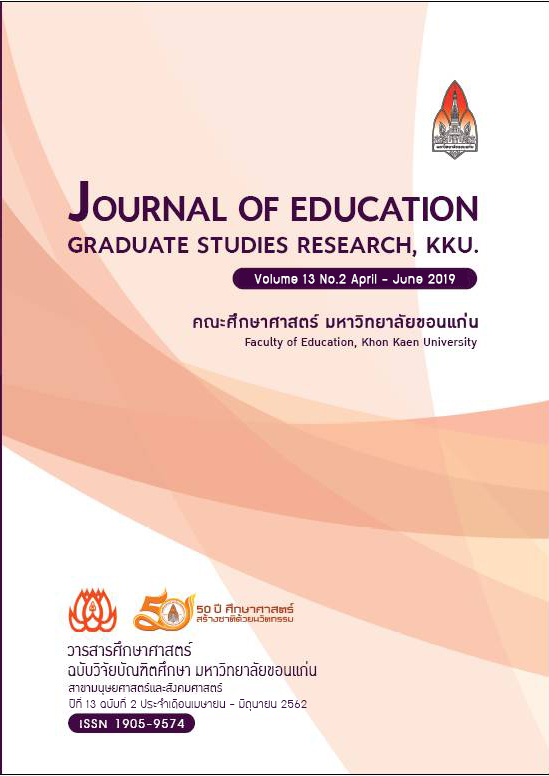The Development of Mathematics Problem Solving Ability for Grade 12 Students Through Open Approach with Polya’s Problem Solving Process
Main Article Content
Abstract
The objectives of this study were 1) to develop grade 12 students’ mathematics solving ability through Open Approach together with Polya’s Problem Solving Process so that the students made a mean score of 70% of the full marks or better on mathematics solving ability, and that at least 70% of the target group pass the criterion and 2) to enhance the students’ learning achievement in mathematics through Open Approach together with Polya’s Problem Solving Process so that the students made a mean learning achievement score of 70% or better in mathematics, and that at least 70% of the target group pass the criterion. The target group consisted of 29 grade-12 students in Phoowittaya School in Nakhon Ratchasima Province, under The Office of Secondary Education Service Area 31, during the first semester of the 2018 academic year. The study followed Action Research procedures for data collection, and the research tools used in the 3 spirals of action consisted of 1) 6 lesson plans on K33101, Basic Mathematics using the Open Approach together with Polya’s Problem Solving Process which took 12 instructional periods, 2) reflection tool which comprised a teacher’s teaching behavior recording form, a student studying behavior recording form, a student learning achievement recording form, a student interview form and end-of-spiral quizzes and 3) evaluation tool which comprised a 5-question essay test on the students’ mathematics solving ability and a 20-item, 4-choice objective test on the students’ learning achievement in mathematics. Analysis of the collected quantitative data was made by means of calculating arithmetic mean, standard deviation and percentage, while the qualitative data were analyzed by means of testing content validity.
The findings show that:
- The students made a mean score of 36.24 or 72.48% of the full marks in mathematics solving ability and 23 students or 79.31% of the target group passed the criterion of 70% which is higher than the prescribed criterion, and also found that the students know how to plan the work step by step. They can think of problems solving in a variety ways. They have assertiveness and can exchange their knowledge together. They have fun and enjoy when they participate in the activities. They also improve their mathematical solving problems as well.
- The students made a mean learning achievement score of 14.62 or 73.10% of the full marks and 23 students or 79.31% of the target group passed the criterion of 70% which is higher than the prescribed criterion, and found that students can think, analyze, and understand the problems and apply in other situations.
Article Details
References
กระทรวงศึกษาธิการ. (2551). หลักสูตรแกนกลางการศึกษาขั้นพื้นฐาน พุทธศักราช 2551. กรุงเทพฯ: ชุมนุมสหกรณ์การเกษตรแห่งประเทศไทย.
กระทรวงศึกษาธิการ. (2553). พระราชบัญญัติการศึกษาแห่งชาติ พ.ศ.2542 แก้ไขเพิ่มเติม (ฉบับที่ 2) พ.ศ. 2545 และ (ฉบับที่ 3) พ.ศ. 2553. กรุงเทพฯ: องค์การค้าและรับส่งสินค้าและพัสดุภัณฑ์.
ตติมา ทิพย์จินดาชัยกุล. (2556). ผลการจัดกิจกรรมการเรียนรู้โดยใช้วิธีการแบบเปิด (Open Approach) ที่มีต่อความสามารถในการแก้ปัญหาและความสามารถในการให้เหตุผลทางคณิตศาสตร์ เรื่องทักษะกระบวนการทางคณิตศาสตร์ของนักเรียนชั้นมัธยมศึกษาปีที่ 3. ปริญญานิพนธ์การศึกษามหาบัณฑิต สาขาวิชาการมัธยมศึกษาบัณฑิตวิทยาลัย มหาวิทยาลัยศรีนครินทรวิโรฒ.
มานิดา อินทรแพทย์. (2558). การพัฒนากระบวนการแก้ปัญหาของนักเรียนชั้นมัธยมศึกษาปีที่ 3 ด้วยนวัตกรรมการศึกษาชั้นเรียนและวิธีการแบบเปิด. วิทยานิพนธ์ปริญญาศึกษาศาสตรมหาบัณฑิต สาขาวิชาหลักสูตรและการสอน บัณฑิตวิทยาลัย มหาวิทยาลัยขอนแก่น.
ไพรจิตร บ้านเหล่า. (2551). การพัฒนาทักษะการคิด โดยวิธีการสอนแบบเปิด (Open Approach) นักเรียนชั้นมัธยมศึกษาปีที่ 2. วิทยานิพนธ์ปริญญาศึกษาศาสตรมหาบัณฑิต สาขาวิชาหลักสูตรและการสอน บัณฑิตวิทยาลัย มหาวิทยาลัยขอนแก่น.
ไมตรี อินทร์ประสิทธิ์ และคณะ. (2546). การปฏิรูปกระบวนการเรียนรู้วิชาคณิตศาสตร์ในโรงเรียนโดยเน้นกระบวนการทางคณิตศาสตร์. ขอนแก่น: ขอนแก่นการพิมพ์.
ศิรภัสสร ศรเสนา. (2557). ความสามารถในการแก้ปัญหาอย่างสร้างสรรค์ของนักเรียนชั้นมัธยมศึกษาปีที่ 3 ที่เรียนด้วยวิธีการแบบเปิด. วิทยานิพนธ์ปริญญาศึกษาศาสตรมหาบัณฑิต สาขาวิชาหลักสูตรและการสอน บัณฑิตวิทยาลัย มหาวิทยาลัยขอนแก่น.
สถาบันทดสอบทางการศึกษาแห่งชาติ. (2559). รายงานผลการทดสอบทางการศึกษาระดับชาติขั้นพื้นฐาน (O - NET) ชั้นมัธยมศึกษาปีที่ 6 ปีการศึกษา 2559 โรงเรียนภู่วิทยา. กรุงเทพฯ: สถาบันทดสอบทางการศึกษาแห่งชาติ.
ศิรภัสสร ศรเสนา. (2560). รายงานผลการทดสอบทางการศึกษาระดับชาติขั้นพื้นฐาน (O - NET) ชั้นมัธยมศึกษาปีที่ 6 ปีการศึกษา 2560 โรงเรียนภู่วิทยา. กรุงเทพฯ: สถาบันทดสอบทางการศึกษาแห่งชาติ.
สุนันทา แสงสุข. (2556). การพัฒนากิจกรรมการเรียนรู้โดยใช้รูปแบบการจัดการเรียนรู้ตามแนวคอนสตรัคติวิสต์ที่เน้นทักษะการแก้ปัญหาทางคณิตศาสตร์ เรื่องบทประยุกต์ ชั้นประถมศึกษาปีที่ 5. วิทยานิพนธ์ปริญญาศึกษาศาสตรมหาบัณฑิต สาขาวิชาหลักสูตรและการสอน บัณฑิตวิทยาลัย มหาวิทยาลัยขอนแก่น.
อเนก จันทรจรูญ. (2545). การพัฒนาความสามารถในการแก้ปัญหาทางคณิตศาสตร์ของนักเรียนชั้นประถมศึกษาปีที่ 6 โดยใช้ชุดการเรียนการสอน. ปริญญานิพนธ์การศึกษามหาบัณฑิต สาขาวิชาคณิตศาสตร์ บัณฑิตวิทยาลัย มหาวิทยาลัยศรีนครินทรวิโรฒ.
อินทิรา ศรีอรุณ. (2556). การพัฒนาทักษะการแก้ปัญหาและผลสัมฤทธิ์ทางการเรียน สาระเศรษฐศาสตร์ ของนักเรียนชั้นประถมศึกษาชั้นปีที่ 6 โดยใช้การจัดการเรียนรู้แบบเปิด (Open Approach) ด้วยกระบวนการศึกษาชั้นเรียน (Lesson Study). วารสารคณะศึกษาศาสตร์ มหาวิทยาลัยขอนแก่น, 4(3), 79-88.
Charles, R. I., & Lester, F. K. (1977). Teaching problem solving: What, Why and How. CA: Dale Seymour Publications.
Kemmis, S., & McTaggart, R. (1999). The Action Research Planner. 3rded. California: Midwest Publication.
Nohda, N. (1984). The Heart of the Open Approach in Mathematics Teaching. In Kawaguchi, T. (Ed.). Proceeding of the ICTM-JSME regional confluence on Mathematics Educations. New York: Mc Millan Publishing.
Polya, G. (1957). How To Solve it A New Aspect of Mathematical Method. New York: Doubleday.
Sawada, T. (1997). Developing Lesson Plans. In Becker, J. P., & Shimada, S. (Eds.). The Open-Ended Approach: A New Proposal for Teaching Mathematics. (pp. 5-10). Reston, VA: National Council of Teachers of Mathematics.

